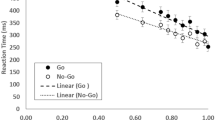Abstract
We conducted two experiments using search asymmetry to test two theories of sustained attention lapses currently debated in the literature: the mindlessness theory and the resource theory. In the first experiment, participants performed a feature present and a feature absent sustained attention to response task (SART). The mindlessness theory predicts more commission errors in a feature present SART than a feature absent SART, while resource theory predicts the reverse, i.e. more commission errors in a feature absent SART than feature present SART. The latter occurred. In the second study, participants performed a naturalistic scene vigilance task with targets more analogous to a feature present search or more analogous to a feature absent search. The vigilance decrement occurred, with an increase in reaction time to targets over the course of the vigil. The decrement was more pronounced with the targets more analogous to a feature absent search. Overall, the results of both studies support a resource theory of sustained attention lapses, not the mindlessness theory.




Similar content being viewed by others
References
Berto, R. (2005). Exposure to restorative environments helps restore attentional capacity. Journal of Environmental Psychology, 25, 249–259.
Buck, L. (1966). Reaction time as a measure of perceptual vigilance. Psychological Bulletin, 65, 291–304.
Davies, D. R., & Parasuraman, R. (1982). The psychology of vigilance. London: Academic Press.
Forster, S., & Lavie, N. (2009). Harnessing the wandering mind: The role of perceptual load. Cognition, 111, 345–355.
Giambra, L. M. (1995). A laboratory based method for investigating influences on switching attention to task unrelated imagery and thought. Consciousness and Cognition, 4, 1–21.
Greene, M. R., & Oliva, A. (2009). The briefest of glances: The time course of natural scene understanding. Psychological Science, 20, 464–472.
Hancock, P. A., & Hart, S. G. (2002). Defeating terrorism: What can human factors/ergonomics offer? Ergonomics and Design, 10, 6–16.
Hancock, P. A., & Warm, J. S. (1989). A dynamic model of stress and sustained attention. Human Factors, 31, 519–537.
Helton, W. S. (2009). Impulsive responding and the sustained attention to response task. Journal of Clinical and Experimental Neuropsychology, 31, 39–47.
Helton, W. S., Dember, W. N., Warms, J. S., & Matthews, G. (2000). Optimism, pessimism, and false failure feedback: Effects on vigilance performance. Current Psychology, 18, 311–325.
Helton, W. S., Hayrynen, L., & Schaeffer, D. (2009a). Sustained attention to local and global target features is different: Performance and tympanic membrane temperature. Brain and Cognition, 71, 9–13.
Helton, W. S., Hollander, T. D., Warm, J. S., Matthews, G., Dember, W. N., Wallart, M., et al. (2005). Signal regularity and the mindlessness model of vigilance. British Journal of Psychology, 96, 249–261.
Helton, W. S., Kern, R. P., & Walker, D. R. (2009b). Conscious thought and the sustained attention to response task. Consciousness and Cognition, 18, 600–607.
Helton, W. S., Matthews, G., & Warm, J. S. (2009c). Stress state mediation between environmental variables and performance: The case of noise and vigilance. Acta Psychologica, 130, 204–213.
Helton, W. S., Shaw, T., Warm, J. S., Matthews, G., & Hancock, P. A. (2008). Effects of warned and unwarned demand transitions on vigilance performance and stress. Anxiety, Stress and Coping, 21, 173–184.
Helton, W. S., & Warm, J. S. (2008). Signal salience and the mindlessness theory of vigilance. Acta Psychologica, 129, 18–25.
Helton, W. S., Weil, L., Middlemiss, A., & Sawers, A. (2010). Global interference and spatial uncertainty in the Sustained Attention to Response Task (SART). Consciousness and Cognition, 19, 77–85.
Hitchcock, E. M., Dember, W. N., Warm, J. S., Maroney, B. W., & See, J. (1999). Effects of cueing and knowledge of results on workload and boredom in sustained attention. Human Factors, 41, 365–372.
Hitchcock, E. M., Warm, J. S., Matthews, G., Dember, W. N., Shear, P. K., Tripp, L. D., et al. (2003). Automation cueing modulates cerebral blood flow and vigilance in a simulated air traffic control task. Theoretical Issues in Ergonomic Science, 4, 89–112.
Kahneman, D. (1973). Attention and effort. Englewood, NJ: Prentice Hall.
Kantowitz, B. H. (1985). Channels and stages in human information processing: A limited analysis of theory methodology. Journal of Mathematical Psychology, 29, 135–174.
Kaplan, S. (1978). Attention and fascination: The search for cognitive clarity. In S. Kaplan & R. Kaplan (Eds.), Humanscape: Environments for people. Ann Arbor, MI: Ulrich.
Kaplan, S. (1995). The restorative benefits of nature: Towards an integrative framework. Journal of Environmental Psychology, 15, 169–182.
Kemp, S. (1984). Reaction time to a tone in noise as a function of the signal-to-noise ratio and tone level. Perception & Psychophysics, 36, 473–476.
Mackworth, N. H. (1948). The breakdown of vigilance during prolonged visual search. Quarterly Journal of Experimental Psychology, 1, 6–21.
Mackworth, N. H. (1950). Researches on the measurement of human performance. Medical Research Council Special Report, No. 2680. London: H.M.S.O. (Reprinted from Selected papers in the design and use of control systems, pp. 174–331, by H.W. Sinaiko, Ed., 1961, New York: Dover).
Manly, T., Robertson, I. H., Galloway, M., & Hawkins, K. (1999). The absent mind: Further investigations of sustained attention to response. Neuropsychologia, 37, 661–670.
Martin, M., Sadlo, G., & Stew, G. (2006). The phenomenon of boredom. Qualitative Research in Psychology, 3, 193–211.
Matthews, G., Davies, D. R., Westerman, S. J., & Stammers, R. B. (2000). Human performance: Cognition stress and individual differences. East Sussex, UK: Psychology Press.
Maxwell, S. E., & Delaney, H. D. (2004). Designing experiments and analyzing data: A model comparison perspective (2nd ed.). Mahwah, NJ: Erlbaum.
McGrath, J. J. (1963). Some problems of definitions and criteria in the study of vigilance performance. In D. N. Buckner & J. J. McGrath (Eds.), Vigilance: A symposium (pp. 227–237). New York: McGraw-Hill.
McVay, J. C., & Kane, M. J. (2009). Conducting the train of thought: Working memory capacity, goal neglect, and mind wandering in an executive-control task. Journal of Experimental Psychology. Learning, Memory, and Cognition, 35, 196–204.
Oliva, A., & Torralba, A. (2001). Modeling the shape of the scene: A holistic representation of the spatial envelope. International Journal of Computer Vision, 42, 145–175.
Parasuraman, R. (1979). Memory load and event rate control sensitivity decrements in sustained attention. Science, 205, 924–927.
Quinlan, P. T. (2003). Visual feature integration theory: Past, present, and future. Psychological Bulletin, 129, 643–673.
Robertson, I. H., Manly, T., Andrade, J., Baddeley, B. T., & Yiend, J. (1997). “Oops!”: Performance correlates of everyday attentional failures in traumatic brain injured and normal subjects. Neuropsychologia, 35, 747–758.
Santee, J. L., & Egeth, H. E. (1982). Do reaction time and accuracy measure the same aspects of letter recognition? Journal of Experimental Psychology: Human Perception and Performance, 8, 489–501.
Scerbo, M. (1998). What’s so boring about vigilance? In R. B. Hoffman, M. F. Sherrick, & J. S. Warm (Eds.), Viewing psychology as a whole: The integrative science of William N. Dember (pp. 145–166). Washington, DC: APA.
Scerbo, M. W., Greenwald, C. W., & Sawin, D. A. (1993). The effects of subject-controlled pacing and task type on sustained attention and workload. The Journal of General Psychology, 120, 293–307.
Schnittger, C., Johannes, S., Arnavaz, A., & Munte, T. F. (1997). Relation of cerebral blood flow velocity and level of vigilance in humans. NeuroReport, 8, 1637–1639.
See, J. E., Howe, S. R., Warm, J. S., & Dember, W. N. (1995). A meta-analysis of the sensitivity decrement in vigilance. Psychological Bulletin, 117, 230–249.
Shaw, T. H., Warm, J. S., Finomore, V., Tripp, L., Matthews, G., Weiler, E., et al. (2009). Effects of sensory modality on cerebral blood flow velocity during vigilance. Neuroscience Letters, 461, 207–211.
Smallwood, J., Davies, J. B., Heim, D., Finnigan, F., Sudberry, M., O’Conner, R., et al. (2004). Subjective experience and the attentional lapse: Task engagement and disengagement during sustained attention. Consciousness and Cognition, 13, 657–690.
Teichner, W. H. (1974). The detection of a simple visual signal as a function of time on watch. Human Factors, 16, 339–353.
Temple, J. G., Warm, J. S., Dember, W. N., Jones, K. S., La Grange, C. M., & Matthews, G. (2000). The effects of signal salience and caffeine on performance, workload and stress in an abbreviated vigilance task. Human Factors, 42, 183–194.
Treisman, A. M., & Gelade, G. (1980). A feature integration theory of attention. Cognitive Psychology, 12, 97–136.
Treisman, A. M., & Gormican, S. (1988). Feature analysis in early vision: Evidence from search asymmetries. Psychological Bulletin, 95, 15–48.
Warm, J. S. (1984). An introduction to vigilance. In J. S. Warm (Ed.), Sustained attention in human performance (pp. 1–14). Chichester, UK: Wiley.
Warm, J. S. (1993). Vigilance and target detection. In B. M. Huey & C. D. Wickens (Eds.), Workload transitions: Implications for individual and team performance (pp. 139–170). Washington, DC: National Academy Press.
Warm, J. S., Parasuraman, R., & Matthews, G. (2008). Vigilance requires hard mental work and is stressful. Human Factors, 50, 433–441.
Weissman, D. H., Roberts, K. C., Visscher, K. M., & Woldorff, M. G. (2006). The neural bases of momentary lapses of attention. Nature Neuroscience, 9, 971–978.
Author information
Authors and Affiliations
Corresponding author
Rights and permissions
About this article
Cite this article
Helton, W.S., Russell, P.N. Feature absence–presence and two theories of lapses of sustained attention. Psychological Research 75, 384–392 (2011). https://doi.org/10.1007/s00426-010-0316-1
Received:
Accepted:
Published:
Issue Date:
DOI: https://doi.org/10.1007/s00426-010-0316-1




